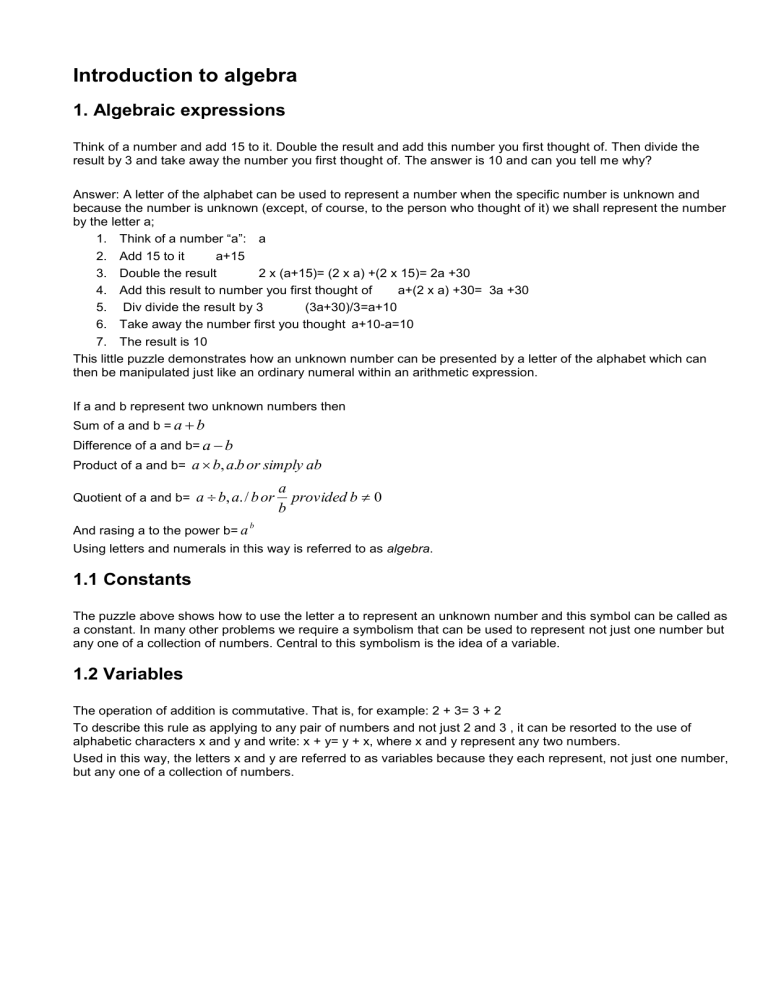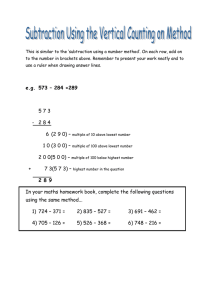
Introduction to algebra 1. Algebraic expressions Think of a number and add 15 to it. Double the result and add this number you first thought of. Then divide the result by 3 and take away the number you first thought of. The answer is 10 and can you tell me why? Answer: A letter of the alphabet can be used to represent a number when the specific number is unknown and because the number is unknown (except, of course, to the person who thought of it) we shall represent the number by the letter a; 1. Think of a number “a”: a 2. Add 15 to it a+15 3. Double the result 2 x (a+15)= (2 x a) +(2 x 15)= 2a +30 4. Add this result to number you first thought of a+(2 x a) +30= 3a +30 5. Div divide the result by 3 (3a+30)/3=a+10 6. Take away the number first you thought a+10-a=10 7. The result is 10 This little puzzle demonstrates how an unknown number can be presented by a letter of the alphabet which can then be manipulated just like an ordinary numeral within an arithmetic expression. If a and b represent two unknown numbers then Sum of a and b = a b Difference of a and b= a b Product of a and b= a b, a.b or simply ab Quotient of a and b= a b, a. / b or And rasing a to the power b= a a provided b 0 b b Using letters and numerals in this way is referred to as algebra. 1.1 Constants The puzzle above shows how to use the letter a to represent an unknown number and this symbol can be called as a constant. In many other problems we require a symbolism that can be used to represent not just one number but any one of a collection of numbers. Central to this symbolism is the idea of a variable. 1.2 Variables The operation of addition is commutative. That is, for example: 2 + 3= 3 + 2 To describe this rule as applying to any pair of numbers and not just 2 and 3 , it can be resorted to the use of alphabetic characters x and y and write: x + y= y + x, where x and y represent any two numbers. Used in this way, the letters x and y are referred to as variables because they each represent, not just one number, but any one of a collection of numbers. 2. Rules for algebra 2.1 Commutative Two numbers x and y can he added or multiplied in any order without affecting the result. That is: x y y x and xy yx Addition and rnultiplication are commutative operations. The order in which two numbers are subtracted or divided does affect the result. That is: x y y x and unless x y x y y x unless x y and neither equals 0 Subtraction and division are not commutative operations except in very special cases 2.2 Associative The way in which the numbers x, y and z are associated under addition or multiplication does not affect the result. That is: x ( y z ) ( x y ) z x y z and x( yz ) ( xy) z xyz Addition and rnultiplication are commutative operations. The way in which the numbers are associated under subtraction or division does affect the result. That is: x ( y z ) ( x y ) z unless z 0 and x ( y z ) ( x y ) z unless z 1 and y 0 Subtraction and division are not associative operations except in very special cases. 2.3 Distributive Multiplication is distributed over addition and subtraction from both the left and the right. For example: x( y z ) xy xz and ( x y ) z xz yz x( y z ) xy xz and ( x y ) z xz yz Division is distributed over addition and subtraction from the right but not from the left. For example: ( x y ) z ( x z ) ( y z ) but x ( y z) ( x y) ( x z) that is : x y x y x x x but z z z yz y z 2.4 Rules of precedence The familiar rules of precedence continue to apply when algebraic expressions involving mixed operations are to be manipulated. 3. Terms and coefficients An algebraic expression consists of alphabetic characters and numerals linked together with the arithmetic operators. For example: 8 x 3 xy is an algebraic expression in the two variables x and y. Each component of this expression is called a term of the expression. Here there are two terms, namely: the x term and the xy term. The numerals in each term are called the coefficients of the respective terms so that: 8 is the coefficient of the x term and -3 is the coefficient of the xy term. 3.1 Collecting like terms Terms which have the same variables are called like terms and like terms can be collected together by addition or subtraction. For example: 4 x 3 y 2 z 5 y 3x 4 z can be rearranged as 4 x 3x 3 y 5 y 2 z 4 z and simplified to: x 8 y 2 z . 3.2 Similar terms In the algebraic expression: ab + bc , both terms contain the letter b and for this reason these terms, though not like terms, are called similar terms. Common symbols such as this letter b are referred to as common factors and by using brackets these common factors can be factored out. For example, the common factor b in this expression can be factored out to give: ab bc b( a c) and this process is known as factorization. Numerical factors are factored out in the same way. For example, in the algebraic expression 3 pq 3qr , the terms are similar, both containing the letter q. They also have a common coefficient 3 and this, as well as the common letter q, can be factored out to give: 3 pq 3qr 3q( p r ) . 3.3 Expanding brackets Sometimes it will be desired to reverse the process of factorizing an expression by removing the brackets. This is done by: (a) Multiplying or dividing each term inside the bracket by the term outside the bracket, but (b) If the term outside the bracket is negative then each term inside the bracket changes sign. For example the brackets in the expression: 3x( y 2 z ) are removed to give 3xy 6 xz and the brackets in the expression 2 y (2 x 4 z ) are removed to give 4 yx 8 yz . 3.4 Nested brackets Whenever an algebraic expression contains brackets nested within other brackets the innermost brackets are removed first. For example: 7(a [4 5(b 3a )]) 7(a [4 5b 15a ]) 7(a 4 5b 15a ) 7 a 28 35b 105a 35b 98a 28 3.5 Transportation When one variable is expressed in terms of other variables, this variable is called the subject of the formula. For example: In the formula t 2a b c , t is expressed in terms of a, b, c and so t is the subject of the formula. So if c is needed to be the subject then, 2 t 2a b c 2 c 2 2a b t c 2a b t 4. Equation Because different values of the variables and constants produce different values for the expression, these expression values are assigned to another variable and so form an equation. For exam, the equation; r 2s 2 3t states that the variable r can be assigned values by successively assigning values to s and to t, each 2 time evaluating 2 s 3t . The subjective variable r is called dependent variable and its value depends on the values of the independent variables s and t. An equation is a statement of the equality of two expressions but there are different types of equations. 4.1 Identity An identity is a statement of equality of two expressions that is true for all values of the symbols for which both expressions are defined. For example, the equation; 2(5 x) 10 2 x is true no matter what value is chosen for x - it is an identity. The expression on the left is not just equal to the expression on the right, it is equivalent to it one expression is an alternative form of the other. Hence the symbol which stands for ‘is equivalent to’. 4.2 Defining equation A defining equation is a statement of equality that defines an expression. For example: a symbolism a 2 is defined to mean a a where 2 a a . Here the means ‘is defined to be’. 4.3 Assigning equation An assigning equation is a statement of equality that assigns a specific value to a variable. For example: p : 4 Here, the value 4 is assigned to the variable p. 4.4 Formula A formula is a statement of equality that expresses a mathematical fact where all the variables, dependent and independent, are well-defined. For example, the equation; A r 2 A expresses the fact that the area A of a circle of radius r is given as r . 2 The uses of , and so, it is acceptable. : as connectives are often substituted by the = sign. While it is not strictly correct to do 5. Linear Equation Linear equation in a single variable (unknown) involves powers of the variable no higher than the first. A linear equation is also referred to as a simple equation. 5.1 Solution of simple equations The solution of simple equations consists essentially of simplifying the expression on each side of the equation to obtain an equation of the form ax b cx d giving ax cx d b and hence x d b provided a c . ac 6. Linear Graph 6.1 Plotting Linear Graphs To plot a straight line graph we need to find the coordinates of at least two points that fit the rule. Example: Plot the graph of y 3 x 2 . Construct a table and choose simple x values. The table of values obtained after entering the values of y is as follows: Draw a Cartesian plane and plot the points. Then join the points with a ruler to obtain a straight line graph. 7. Simultaneous linear equations with two unknowns A linear equation in two variables has an infinite number of solutions. For example, the two-variable linear equation y x 3 can be transposed to read as y x 3 Any one of an infinite number of x-values can be substituted into this equation and each one has a corresponding y-value. However, for two such equations there may be just one pair of x- and y-values that satisfy both equations simultaneously. 7.1 Solution by substitution Example: 7.2 Solution by equating coefficients Example:

